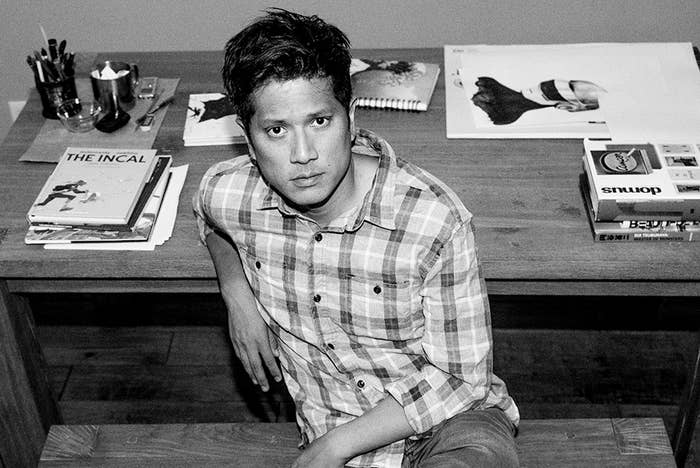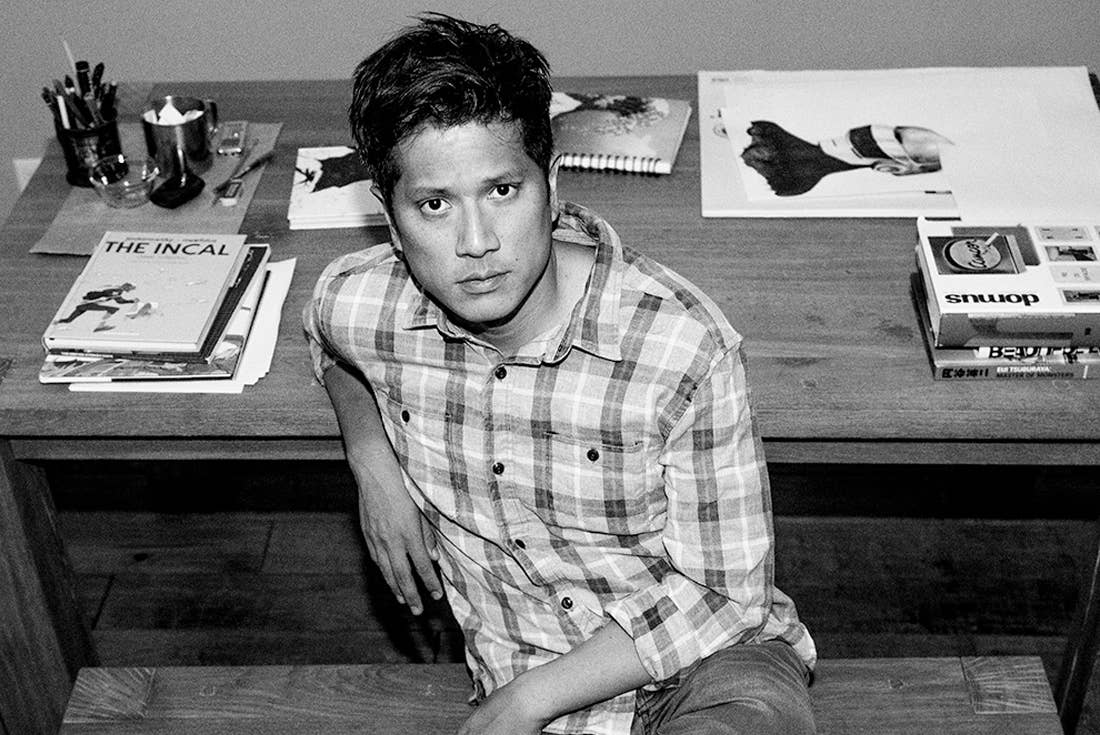
I was in high school when I first saw the video for Mark Ronson’s "Bang Bang Bang". It was one of Warren Fu’s first stints as a music video director, and one of two videos he’d helm for the British producer in 2010. I was blown away by Fu’s retro-futurist aesthetic that propelled Ronson’s synths into hyperspace. For any fans of Sofia Coppola’s Lost In Translation (2003), you may recall the scene where Bob Harris (played by Bill Murray) goes on Japanese game show Matthew’s Best Hit TV. The eccentric, dyed-blond host rattles off Japanese to a bewildered Bob, who manages only with the help of an English translator. Fu captures this stilted communication between cultures with Ronson’s appearance on a ‘70s Japanese talk show.
“We thought it would be funny if the Asian talk show host was speaking French and Mark was speaking Japanese,” Fu recalls. “[Mark] had sent me songs from Yellow Magic Orchestra, a Japanese electronic band, to inspire me. There are some French lyrics [in "Bang Bang Bang"], and then there’s the hip-hop aspect, with a breakbeat and the sampling of funk breaks in the verses, then it goes into an electro drop with a higher BPM. It just felt like a mish-mash of all cultures.”
The art of blending cultures came to Fu at a young age. Born in Chicago to Taiwanese parents, his ABC (American-born Chinese) roots would come to shape his worldview. “I think Asian-Americans are kind of caught between two worlds, and it makes you more aware of being an outsider. As a Taiwanese, my grandparents had a bit of Japanese influence in their culture, which shaped it to be slightly different from mainland Chinese-Americans. I love having this mix of outsider/insider perspectives on things – it can make you more open-minded in the long run,” Fu says.
Seven years, and an enviable list of collaborations later, Fu has revisited the cross-cultural talk show format in directing Phoenix’s "J-Boy", the first single off their upcoming album 'Ti Amo'. “This was actually Phoenix’s idea!” Fu exclaims. “I’m sure they’d seen the Mark Ronson one, which is why they asked me to do this video. They had this idea of creating this old show, and showed me all these old clips of various bands performing internationally, and feeling a little bit lost. They wanted to capture that feeling of discomfort, and having to win over the crowd.”
The clip oozes ‘70s Italian nostalgia through hazy lens flare, gaudy set design and disco attire, all wrapped nicely in 4:3 ratio. A YouTube user suggests “[turning] it down to 360p for the full aesthetics.” Fu’s album art for 'Ti Amo' harks back to one of his childhood loves – graffiti. The words “PHOENIX Ti AMO” are encased in a heart, and scrawled in red crayon on a peeling blue wall. The design is simple, yet true to the band’s vision of a fantasised Italian summer. It’s also loosely based on a draft that singer Thomas Mars scribbled on a napkin. “There was something so candid, real and sincere about his original handwriting that I made sure I captured that energy and looseness in the final cover,” Fu says.
Graffiti also lends itself to the album art for Julian Casablancas and the Voidz’ 'Tyranny'. Casablancas and Fu have been collaborating since Fu submitted a fan-made video concept for The Strokes’ "You Only Live Once" in 2007. “Graffiti kind of opened up my world in a way,” Fu recalls. “Julian [Casablancas] always had an appreciation for it as well, especially growing up in NYC, which is full of tags, stickers and subway throw-ups. So when it came to do the Voidz record, we knew we wanted to do something different than we had done with 'Phrazes for the Young' (Casablancas’ solo album). The graf look just seemed like a natural extension of the music and vibe of the band.” Fu’s artistic contributions to 'Tyranny' include music videos, video teasers, logos, and album packaging for CD, vinyl, cassette, and – most memorably, cigarette lighter-shaped USBs containing MP3 files.
It’s rare to find artistic collaborations of such contemplation and caliber these days. In the right musician’s hands, music can be incredibly visual in itself. It’s no wonder then, that matching beats with a visual artist that understands and aligns with the musician’s vision would amplify these soundscapes to dizzying heights. Fu is well versed in these partnerships, but has designated 'Ti Amo' as his final album art project. “As much as I would like to do more album art, the reality is that we all have a finite time on this planet, and I really want to focus on directing. I feel like filmmaking is one of those art forms that you can spend a lifetime learning about and still have so much more to learn. With every project I direct, I tend to be very critical of it afterwards, and I’m always trying to figure out how to get better,” Fu says.
Fu played auteur throughout Daft Punk’s enigmatic 'Random Access Memories' (2013) period, directing album teasers, music videos, and designing the iconic set during their 2014 Grammys performance. He also created a set of highly sought-after vintage posters that promoted Daft Punk merchandise. It’s been years since the success of 'Random Access Memories', yet this collaboration between Fu and the helmeted duo continues to bear fruit. He recently directed their high-octane video for "I Feel It Coming", which also features The Weeknd. Fu’s retro-futurist aesthetic is back, this time amplifying the bleakness of a cursed planet: The Weeknd traverses through rocky plinths, against startling pink clouds that soar ahead. Incredibly, Fu turned away from using green screens for this project. “I don’t really like the look of green screens – it never feels quite real,” he explains. “Even though we were going for a very stylised look with our skies, I didn’t want it to feel composited. When you have a rear-screen projection, you actually get a lot of natural light spilling from the screen onto your actors that wraps around their skin, clothes and hair.” The result is a celestial dreamscape awash in pink and orange. And the best part about using rear projection over green screens, according to Warren Fu, is that “there’s barely any post-production to do on those shots.”
It’s 2017, and Fu is rightly being lauded the world over for his contributions in visualising soundscapes. He’s being flown down to Australia in June to head the judging panel at Sydney’s Clipped Music Video Festival. When asked what will make entrants stand out over others, Fu says: “videos have different goals. I think one can be purely aesthetic, with no meaning besides being a beautiful representation of the music – and there’s a certain merit to that. Another idea that’s purely conceptual, that might not be beautiful – there’s merit in that too. That’s the real beauty of good music videos – there are no rules. I’m just looking to be surprised.”
Catch Warren Fu at the CLIPPED Festival, June 3 at Sun Studios. More info here.


